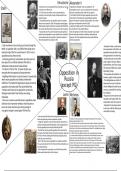Khrushche Alexander II
Stalin promised a more liberal rule.
v -emancipation
- Khrushchev saw more opposition than his predecessor as he
Opposition to Alexander II was very significant. The
was not a success as peasant riots increased as
- In 1962, there were workers’ riots in Novocherkassk in the brutal, controlling nature of the Mir was exposed.
response to economic policy change. People expected more - The People’s Will was the largest opposition group and the
dramatic change. most powerful. They believed in assassinating key political
- The satellite states also saw opposition spark. For example, figures to weaken the autocratic Russian regime. One of these
after the secret speech in 1956, the Hungarian Uprising began. key figures was Alexander II himself in 1881.
2500 Hungarians died, 20,000 were wounded and 200,000 fled - Alexander II initially used The Third Section to exile opponents
the country after Khrushchev’s brutal put down of the uprising. but switched to the less radical Okhrana.
- Towards the end of his career, Khrushchev would experience - After the attempt on his life in 1866, Alexander II stuck closely
greater internal opposition as many viewed him as a betrayal of with the autocratic principles of orthodoxy, nationality and
communist ideas due to his policies of ‘peaceful coexistence.’ autocracy. This led to opposition becoming overall ineffective
This eventually led to his ousting in 1964. until his assassination
- Stalin maintained a very harsh grip on Russia through the - Alexander III took a much firmer
NKVD, so opposition had a very difficult time doing much the assassination of his father. He
during his reign. After he secured power in 1924, no true opposition during his father’s reign
opposition posed a threat to him. through repression and reversing
- Continuing practise of anti-Semitism since the Jews had - Social Democrats and Social Revo
been placed in an artificial settlement (The Pale of came to light in the early 1900s. D
Settlement) continued to be treated harshly. modernisation, new forces of opp
The educated middle class, indust
- The Doctor’s Plot of 1952. 15 Jewish doctors were
executed after being exposed of being subversive.
- Infighting within parties occurred, however it caused splits
Opposition in demanding change.
- The peasants also wished for cha
which meant opposition was divided and therefore Russia freedoms, rights to land and prote
- The Intelligentsia was critical of t
ineffective. This marked the beginning of purges of internal
opposition which lasted until The Second World War. (except PG) subversive texts such as Marxism b
critical intelligentsia made the pop
- Workers were less prone to oppose the communists, conscious, especially the working
although would rebel if they felt they were being for revolution.
mistreated.
Lenin Nicholas - Populism were the extreme radic
- There was a massive overall decrease in opposition under II Narodniks and People’s Will, who
assassination were the answers to
Stalin due to his repressive methods, which ensured no - Alexander III’s repressive system
person or group could ever grow strong enough or to do much, with the Okhrana gain
courageous enough to stand against The Red Tsar. censorship increasing.
- Lenin was faced with the task of securing Bolshevik control over
Russia and repressing counter-revolutionary activity. - Nicholas II’s rule saw opposition make huge strides against the Tsarist regime,
- ‘Moderate’ opponents to the Civil War and War Communism in obviously tearing it down in 1917.
- In July 1904, terrorists succeeded in the murder of Plehve, Minister of the Interior,
particular emerged within the Bolsheviks. Lenin maintained party
who they believed was who to blame for the war with Japan. This led to the Tsar lifting
unity by appeasing them through introducing the NEP. restrictions on the Zemstva and extending press freedom. The Intellegentsia was taking
- The Civil War saw the greatest opposition to the communist in the lead in pressing the regime to make reform.
the shape of the Whites (Tsarist) and Greens (Peasants), along with - In 1906-07, there were significant peasant riots, prompted by food shortages.
the Poles. All three challenged the Red Army during this period, - An urban proletariat began to grow and became more politically conscious, more
mostly for control over Russia. strikes and protest meetings happened. One strike was the Putilov works in St
- After 1918, there was less opposition from national minorities. Petersburg, commonly referred to as the start of the February 1917 Revolution.
- Before 1905, trade unions were banned. From 1905-17 they were allowed to exist but
This was mainly due to the 1918, 1920 and 1936 constitutions and
with very limited powers. Workers councils appeared and were tolerated.
increased repression. - Nicholas II would utilise the army frequently throughout his rule to put down strikes,
- Lenin, through harsh censorship, use of the Red Army and the such as during the Lena goldfield strikes and Bloody Sunday, where 200 died. As a
Cheka would maintain his iron fist on Russia. result, before 1914, workers protests achieved little.




